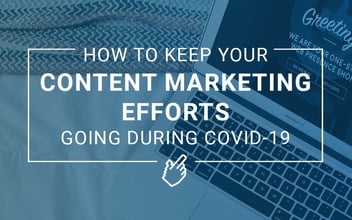Key performance indicators are crucial to understanding whether or not any strategy is working. There are certain KPIs for all aspects of your business. In order to justify cost or resources, it’s imperative you have a wealth of data showing whether or not you’re spending your time and money wisely. It’s impossible to calculate your ROI without any KPIs.
Traffic (The kind you like to see)
Blogging is important. Blogging is important. Blogging is important. No, really. It is. If you had to choose one and only one inbound tactic, blogging would be the one I would choose. Why? It increases traffic.
Weekly blogging compounds over time, allowing your traffic to increase over time as well. This, of course, is assuming you understand your buyer persona, their journey, and that you have done some keyword research. Just think about it. If you blog even once per week, after one year, you would have 52 blog posts. That’s 52 pages for Google to index. That’s 52 opportunities to educate your persona.
Traffic is important. It validates the fruits of your labor. If you are blogging regularly and you’re not seeing your traffic increase, there could be an issue that needs your attention. A few of these potential issues are:
- You’re blogging about the wrong keywords
- Your website isn’t SEO friendly
- You’re not properly using page titles, headers, image alt text, etc.
- Your content isn’t educational
- You’re not promoting it through social media
- You don’t have Google analytics setup properly
If you’re just starting out with an inbound marketing strategy, be sure to set some benchmarks. For example, if you’re at 500 visitors per month right now, in six months time, you should see that number increase. Granted, there’s no magic traffic number, but generally speaking, the higher the number the better (especially if they are converting).
Contacts (And where they came from)
Another key performance indicator to track on a regular basis is new contacts. If you’re seeing an increase in traffic, you should also be seeing an increase in contacts. This is another reason why understanding your buyer personas, their journey, and what they’re searching for is important.
It’s not enough to just attract them to your website; you need to convert them into contacts. You do this through soft conversion opportunities. These are pieces of content someone finds relevant even if they aren’t ready to buy your product or service. For example, a high level ebook, or checklist, is a great awareness-stage content offer. Here’s a look at how you gain new contacts through content offers:
- Website visitor arrives at a blog post based on a google search
- Visitor reads the whole blog post
- Visitor finds blog post incredibly valuable and clicks on a call-to-action for a new checklist relevant to the content they just read
- Visitor fills out the form on your landing page
- Visitor is taken to a thank you page, where they can download their offer and becomes a contact
Yes, inbound is beautiful.
Lifetime Value of a Customer
The lifetime value of a customer is a crucial thing to understand when conducting a cost-benefit analysis for your marketing efforts. You may have four different types of customers. For the sake of example, and because I love baseball, let’s call them singles, doubles, triples, and home runs.
- Single - The lowest initial purchase but the highest frequency
- Double - Larger initial purchase, decent frequency
- Triple - Very large initial purchase, repeat customer, high lifetime value
- Home Run - Largest initial purchase, repeat customer, stays with you forever, sends you a bunch of referrals, etc.
What’s your sweet spot? Which customer is realistic to target? It may make sense for you to go after the singles and doubles, and hope for a triple or a home run now and then.
Close Rate and Revenue from Inbound Leads (Is your sales team sealing the deal?)
One of the many benefits of inbound marketing is that it (ideally) aligns your sales and marketing team. Your marketing team generates awareness and nurtures leads until they’re ready to buy. Once they are ready, the marketing teams sends them to the sales team to do what they do best – which should be to close leads.
In some cases, the marketing team may also be the sales team. That’s OK. Just make sure you are able to identify where the lead is at in their journey.
You don’t want to be too salesy to someone in the awareness stage, but you also shouldn’t be afraid to quote a lead in the consideration or decision stage.
If you’re not closing deals, you have a few things to consider: Is your marketing team handing off the leads too soon? Is your pricing as competitive as you think it is? Is your sales guy just not sealing the deal? In a perfect world the lead should have been educated and nurtured so well that once they reach the decision stage, they already see you as a trusted resource in the industry and will be ready to purchase.
If you need some help…
Inbound marketing can be tough. It’s especially tough when you’re trying to do it all yourself. If you’re struggling to get your campaign off the ground, or you don’t know where to start, give us a call. We’ll be happy to help.





